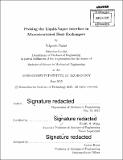| dc.contributor.advisor | Evelyn N. Wang. | en_US |
| dc.contributor.author | Farias, Edgardo | en_US |
| dc.contributor.other | Massachusetts Institute of Technology. Department of Mechanical Engineering. | en_US |
| dc.date.accessioned | 2015-09-29T18:55:36Z | |
| dc.date.available | 2015-09-29T18:55:36Z | |
| dc.date.copyright | 2015 | en_US |
| dc.date.issued | 2015 | en_US |
| dc.identifier.uri | http://hdl.handle.net/1721.1/98961 | |
| dc.description | Thesis: S.B., Massachusetts Institute of Technology, Department of Mechanical Engineering, 2015. | en_US |
| dc.description | Cataloged from PDF version of thesis. | en_US |
| dc.description | Includes bibliographical references (pages 51-52). | en_US |
| dc.description.abstract | This thesis describes two aspects of a project designed to understand the liquid-vapor interface in microstructured heat exchangers. The two aspects include: design and fabrication of a custom vacuum chamber faceplate and the investigation of the liquid meniscus shape on microstructured devices. The faceplate for the vacuum chamber consisted of two metal components that serve to house and seal a viewport. Addition of the viewport to the chamber was of interest so that experimentation within a pure environment could be conducted.The second component of this project was to map the meniscus profile of water on three different device geometries under various conditions by laser interferometry. The first experiment was a transient study where a droplet of water fully evaporated from the surface. The purpose was to determine how the profile changes as evaporation progresses. As evaporation occurs a more curved meniscus is established within the liquid which causes a greater capillary pressure. The second experiment was a steady state study with the samples partially submerged in water. This aimed to determine the profile that arises when evaporation is balanced by fluid replenishment. The profile that arises after the first several microstructure unit cells remains constant for the remainder of the microstructured region of the sample and the meniscus has the highest curvature near the fluid front, indicating a higher capillary pressure. The final experiment was varying heat applied to the surface. The aim was to determine how the applied heat flux changes the steady state profile. With higher temperature more fluid evaporates from the surface, resulting in an increase of meniscus curvature with increased temperature. | en_US |
| dc.description.statementofresponsibility | by Edgardo Farias. | en_US |
| dc.format.extent | 52 pages | en_US |
| dc.language.iso | eng | en_US |
| dc.publisher | Massachusetts Institute of Technology | en_US |
| dc.rights | M.I.T. theses are protected by copyright. They may be viewed from this source for any purpose, but reproduction or distribution in any format is prohibited without written permission. See provided URL for inquiries about permission. | en_US |
| dc.rights.uri | http://dspace.mit.edu/handle/1721.1/7582 | en_US |
| dc.subject | Mechanical Engineering. | en_US |
| dc.title | Probing the liquid-vapor interface in microstructured heat exchangers | en_US |
| dc.type | Thesis | en_US |
| dc.description.degree | S.B. | en_US |
| dc.contributor.department | Massachusetts Institute of Technology. Department of Mechanical Engineering | |
| dc.identifier.oclc | 921147683 | en_US |
